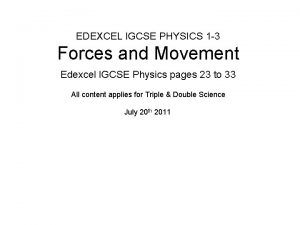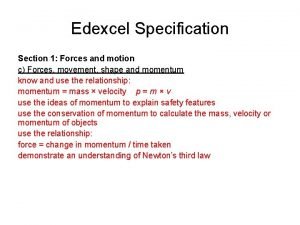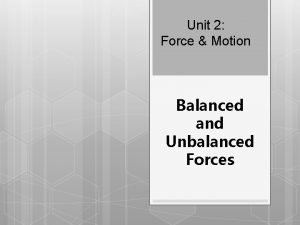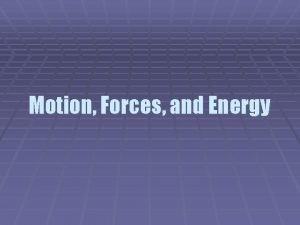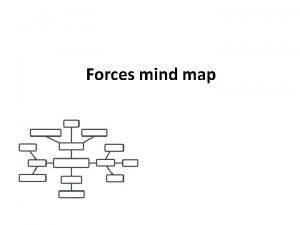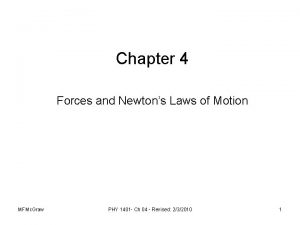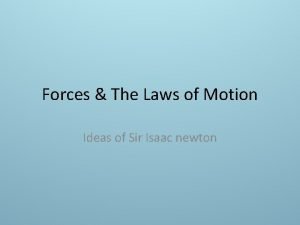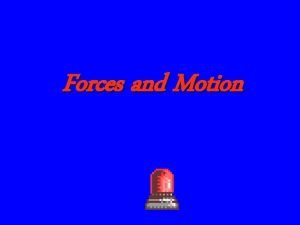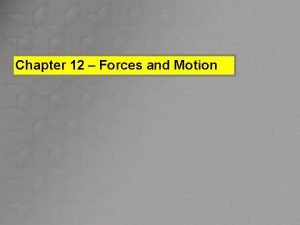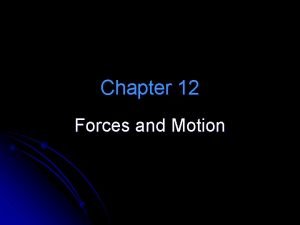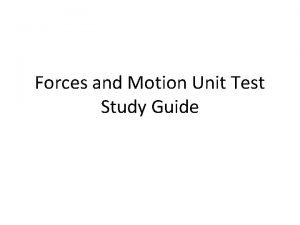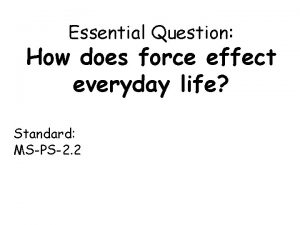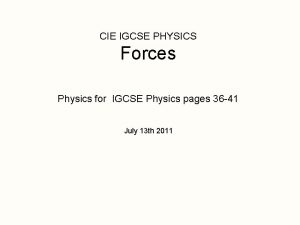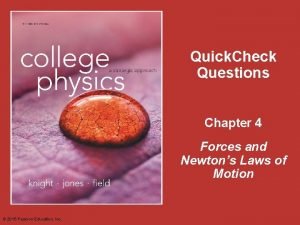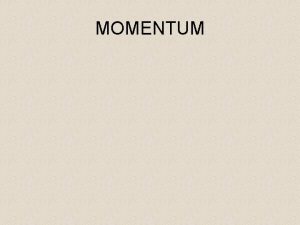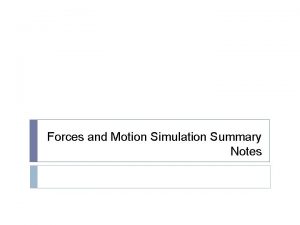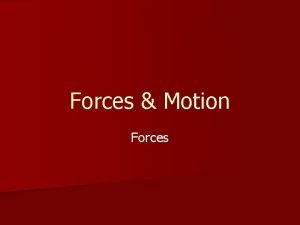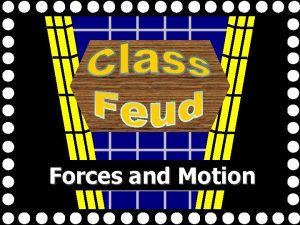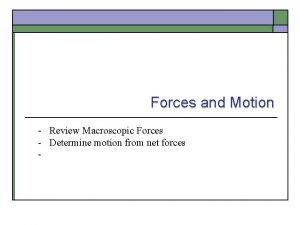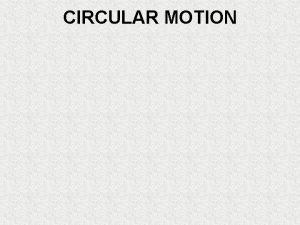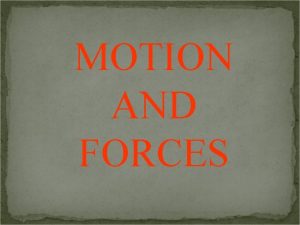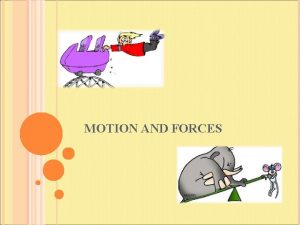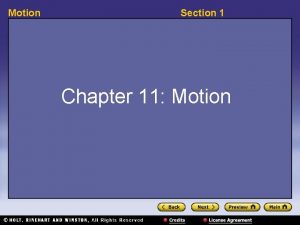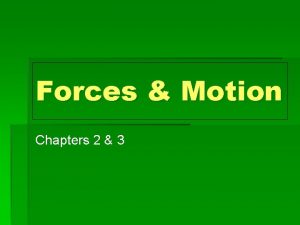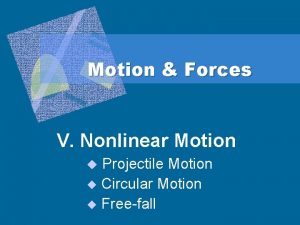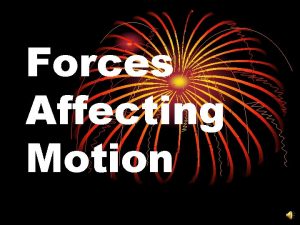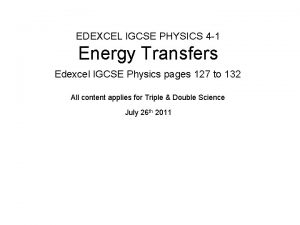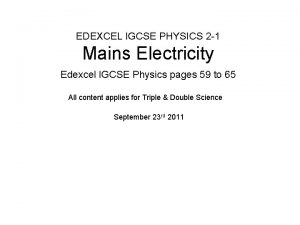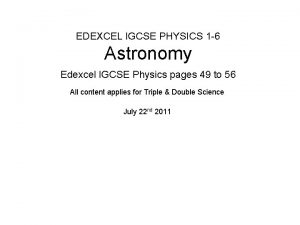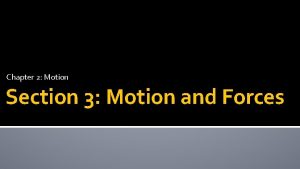Edexcel Specification Section 1 Forces and motion c




































- Slides: 36

Edexcel Specification Section 1: Forces and motion c) Forces, movement, shape and momentum know and use the relationship: momentum = mass × velocity p = m × v use the ideas of momentum to explain safety features use the conservation of momentum to calculate the mass, velocity or momentum of objects use the relationship: force = change in momentum / time taken demonstrate an understanding of Newton’s third law

Momentum (p) momentum = mass x velocity p=mxv mass is measured in kilograms (kg) velocity is measured in metres per second (m/s) momentum is measured in: kilogram metres per second (kg m/s)

Momentum has both magnitude and direction. Its direction is the same as the velocity. The greater the mass of a rugby player the greater is his momentum

Question 1 Calculate the momentum of a rugby player, mass 120 kg moving at 3 m/s. p=mxv = 120 kg x 3 m/s momentum = 360 kg m/s

Question 2 Calculate the mass of a car that when moving at 25 m/s has a momentum of 20 000 kg m/s. p=mxv becomes: m = p ÷ v = 20000 kg m/s ÷ 25 m/s mass = 800 kg

Complete Answers momentum mass velocity 150 kg m/s 50 kg 3 m/s 160 kg m/s 8 kg 20 m/s 1500 kg m/s 250 kg 6 m/s 4 kg m/s 500 g 8 m/s 3 kg m/s kgkg 6 50 cm/s

Force and momentum A force will cause the velocity of an object to change and therefore also its momentum. The greater the force the faster the momentum changes.

Momentum, acceleration and force Consider a body of mass m changing velocity from u to v in time t. acceleration = velocity change ÷ time taken a = (v – u) / t Multiply both sides of this equation by the mass, m gives: ma = m (v – u) / t ma = (mv – mu) / t ma is equal to the force, F causing the acceleration. and (mv – mu) is equal to the momentum change And so: F = (mv – mu) t

force = momentum change time taken for the change force is measured in newtons (N) change in momentum is measured in: kilogram metres per second (kg m/s) time is measured in seconds (s)

Question 1 Calculate the force required to change the momentum of a car by 24000 kgm/s over a 6 second period. force = momentum change ÷ time taken = 24000 kgm/s ÷ 6 s force = 4000 N

Question 2 Calculate the time taken for a force of 6000 N to cause the momentum of truck to change by 42000 kgm/s. force = momentum change ÷ time taken becomes: time taken = momentum change ÷ force = 42000 kgm/s ÷ 6000 N force = 7 seconds

Complete Answers force time taken 200 N momentum change 8000 kgm/s 25 N 500 kgm/s 20 s 500 N 3000 kgm/s 6 s 800 N 8000 kgm/s 10 s 4 N 480 kgm/s 2 minutes 40 s

Momentum conservation Momentum is conserved in any collision or explosion provided no external forces act on the colliding or exploding bodies. The initial momentum of the yellow car has been conserved and transferred to the red car

Question 1 A truck of mass 0. 5 kg moving at 1. 2 m/s collides and remains attached to another, initially stationary truck of mass 1. 5 kg. Calculate the common velocity of the trucks after the collision.

total momentum before collision p=mxv 0. 5 kg truck: = 0. 5 kg x 1. 2 m/s = 0. 6 kg m/s 1. 5 kg truck: = 1. 5 kg x 0 m/s = 0 kg m/s total initial momentum = 0. 6 kg m/s Momentum is conserved in the collision so total momentum after collision = 0. 6 kg m/s total momentum = total mass x velocity 0. 6 kg m/s = 2. 0 kg x v 0. 6 ÷ 2. 0 = v common velocity = 0. 3 m/s

Question 2 A train wagon of mass 800 kg moving at 4 m/s collides and remains attached to another wagon of mass 1200 kg that is moving in the same direction at 2 m/s. Calculate the common velocity of the wagons after the collision.

total momentum before collision p=mxv 800 kg wagon: = 800 kg x 4 m/s = 3200 kg m/s 1200 kg truck: = 1200 kg x 2 m/s = 2400 kg m/s total initial momentum = 5600 kg m/s Momentum is conserved in the collision so total momentum after collision = 5600 kg m/s total momentum = total mass x velocity 5600 kg m/s = 2000 kg x v 5600 ÷ 2000 = v common velocity = 2. 8 m/s

Choose appropriate words to fill in the gaps below: mass multiplied The momentum of an object is equal to its ______ direction by its velocity. Momentum has _____, the same as the velocity, and is measured in kilogram _______ metres per second. forces act In any interaction of bodies, where no external _______ momentum is conserved. on the bodies, _____ In snooker, a head-on collision of a white ball with a red ball same initial can result in the red ball moving off with the ______ velocity of the white ball. This is an example of momentum conservation ______. WORD SELECTION: direction forces same conservation metres momentum mass

Head-on collisions In this case bodies are moving in opposite directions. Momentum has direction. One direction is treated as positive, the other as negative. In calculations the velocity of one of the colliding bodies must be entered as a NEGATIVE number. NEGATIVE DIRECTION OF MOTION + ve velocity - ve velocity POSITIVE

Question 1 A car of mass 1000 kg moving at 20 m/s makes a head-on collision with a lorry of mass 2000 kg moving at 16 m/s. Calculate their common velocity after the collision if they remain attached to each other. lorry, mass 2000 kg car, mass 1000 kg 20 m/s NEGATIVE 16 m/s DIRECTION OF MOTION POSITIVE

total momentum before collision p=mxv car: = 1000 kg x +20 m/s = +20000 kg m/s lorry: = 2000 kg x -16 m/s = -32000 kg m/s total initial momentum = -12000 kg m/s Momentum is conserved in the collision so total momentum after collision = -12000 kg m/s total momentum = total mass x velocity -12000 kg m/s = 3000 kg x v -12000 ÷ 3000 = v common velocity = - 4 m/s The lorry/car combination will move in the original direction of the lorry.

Question 2 A car of mass 1000 kg moving at 30 m/s makes a head-on collision with a lorry of mass 2000 kg moving at 15 m/s. Calculate their common velocity after the collision if they remain attached to each other. lorry, mass 2000 kg car, mass 1000 kg 30 m/s NEGATIVE 15 m/s DIRECTION OF MOTION POSITIVE

total momentum before collision p=mxv car: = 1000 kg x +30 m/s = +30000 kg m/s lorry: = 2000 kg x -15 m/s = -30000 kg m/s total initial momentum = 0 kg m/s Momentum is conserved in the collision so total momentum after collision = 0 kg m/s The lorry/car combination will not move after the collision.

Explosions Before an explosion the total momentum is zero. As momentum is conserved, the total momentum afterwards must also be zero. This means that the different parts of the exploding body must move off in different directions.

Question 1 An artillery gun of mass 1500 kg fires a shell of mass 20 kg at a velocity of 150 m/s. Calculate the recoil velocity of the gun. artillery gun, mass 1500 kg shell, mass 20 kg recoil IO TION O M F NO DIRECT IVE NEGAT 150 m/s VE POSITI

The total momentum before and after the explosion is ZERO p=mxv shell: = 20 kg x +150 m/s = +3000 kg m/s This must cancel the momentum of the gun. Therefore the gun’s momentum must be -3000 kg m/s gun: = 1500 kg x recoil velocity = -3000 kg m/s recoil velocity = - 3000 ÷ 1500 = - 2 m/s The gun will recoil (move to the left) with a velocity of 2 m/s.

Question 2 A girl of mass 60 kg throws a boy, mass 90 kg out off a swimming pool at a velocity of 2 m/s. What is the girl’s recoil velocity? boy, mass 90 kg girl, mass 60 kg 2 m/s recoil DIRECTION OF MOTION NEGATIVE POSITIVE

The total momentum before and after throwing the boy is ZERO p=mxv boy: = 90 kg x +2 m/s = +180 kg m/s This must cancel the momentum of the girl. Therefore the girl’s momentum must be -180 kg m/s gun: = 60 kg x recoil velocity = -180 kg m/s recoil velocity = - 180 ÷ 60 = - 3 m/s The girl will recoil (move to the left) with a velocity of 3 m/s.

Car safety features

Crumple zones, air bags and a collapsible steering wheel are designed to increase the time taken for a driver or passenger to change momentum to zero during a crash. The equation: force = momentum change ÷ time taken shows that if the time taken is increased for the same momentum change the force exerted is decreased so is the injury to the driver or passenger.

Playground flooring question ANSWER: The picture shows rubber tiles used for playground When a child falls to the floor its flooring. Explain how these can reduce injury to children. momentum changes from a high value to zero. The rubber flooring tiles increase the time taken for this change. force = change in momentum ÷ time taken for the change Therefore the force on the child is reduced and so is the potential injury.

Choose appropriate words to fill in the gaps below: momentum The force exerted on an object is equal to the _____ time change caused divided by the ______ taken for the change. crash An airbag activates during a car _______. The inflated increases the time taken for a driver’s or airbag _____ velocity to fall to zero. The time taken for their passenger’s ____ momentum to fall to ______zero is also increased. Therefore the _______ exertedforce on the driver or passenger is _____ decreased injury and so is the potential ____ caused. WORD SELECTION: time velocity zero momentum force decreased injury increases crash

Newton’s 3 rd law of motion states that forces always occur in pairs. Each force has the same size but acts in opposite directions. The law is often expressed as: “To every action there is an equal and opposite reaction” Example 1: The boy and girl are exerting equal and opposite forces on each other

Example 2: Rocket in flight There a pair of forces: A = THRUST of the ROCKET ENGINES DOWNWARDS on the EJECTED GASES A B B = CONTACT push of the EJECTED GASES UPWARDS on the ROCKET ENGINES

Example 3: Tyre-road friction A car is able to move forwards due to friction acting between its tyres and the road. The force of friction of the road on the tyre acts in the forward direction and is equal but in the opposite direction to the force of friction of the tyre on the road.

Choose appropriate words to fill in the gaps below: A force _____ is a push or a pull. A force can cause an object to accelerate ______ or change shape. newtons (N) with a newtonmeter. Force is measured in _______ contact force occurs when There are many types of force. ____ two bodies touch each other. pairs Forces always occur in ______. If a force is exerted on an object there will always be another force, ______ equal in size, ____ direction acting in the opposite ____. WORD SELECTION: newtons accelerate equal force direction contact pairs object
 Formula for weight physics
Formula for weight physics Upper specification limit and lower specification limit
Upper specification limit and lower specification limit Natural variations operations management
Natural variations operations management Chapter 11 section 3 motion and force answer key
Chapter 11 section 3 motion and force answer key Is momentum a force
Is momentum a force Edexcel gcse pe specification
Edexcel gcse pe specification Edexcel business specification
Edexcel business specification Chapter 2 section 1 describing motion answer key
Chapter 2 section 1 describing motion answer key Chapter 2 motion section 1 describing motion answer key
Chapter 2 motion section 1 describing motion answer key Motion section 1 describing motion
Motion section 1 describing motion Chapter 1 lesson 1 position and motion answer key
Chapter 1 lesson 1 position and motion answer key Section 1 describing motion
Section 1 describing motion Key frame systems in computer graphics
Key frame systems in computer graphics Motion specification in computer graphics
Motion specification in computer graphics Parallel forces
Parallel forces Force and motion
Force and motion Force examples in everyday life
Force examples in everyday life Constructive and destructive forces examples
Constructive and destructive forces examples Unbalanced force example
Unbalanced force example Motion forces and energy
Motion forces and energy Forces mindmap
Forces mindmap Force and motion summary
Force and motion summary Derek leaves his physics book on top of a drafting table
Derek leaves his physics book on top of a drafting table Forces and motion jeopardy
Forces and motion jeopardy Chapter 12 forces and motion
Chapter 12 forces and motion Chapter 12 forces and motion
Chapter 12 forces and motion Motion forces and energy
Motion forces and energy Energy and forces unit test
Energy and forces unit test Study jams forces and motion
Study jams forces and motion Types of forces igcse physics
Types of forces igcse physics Balanced forces examples
Balanced forces examples The forces shown above are
The forces shown above are Intermolecular forces vs intramolecular forces
Intermolecular forces vs intramolecular forces Intermolecular forces in a lava lamp
Intermolecular forces in a lava lamp Intermolecular force of attraction
Intermolecular force of attraction Range of motion definition
Range of motion definition 10 year old sarah stands on a skateboard
10 year old sarah stands on a skateboard
